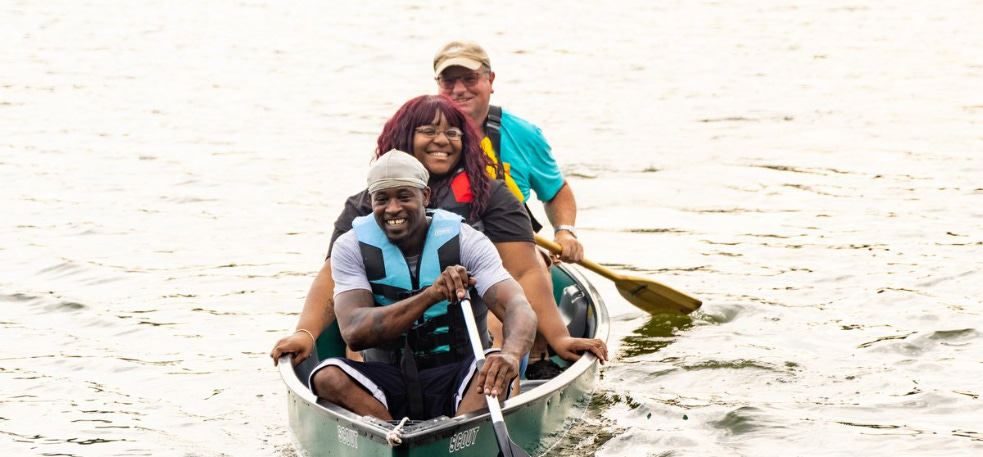Building Connected Communities
Plus, community-based public space, how to be human, and The Folded Map Project
Good morning,
Before we jump into our list of reads for the week, we wanted to share some of our reflections from attending the Building Connected Communities action forum at Harvard earlier this month. With panels spanning topics ranging from “Economic Prosperity & Social Connection,” to “Religious & Spiritual Engagement,” the forum provided an opportunity for us to learn more about many of the themes we’ve begun to surface in this newsletter. It also provided us with an opportunity to engage with the emergent group of practitioners, researchers, and policymakers focused on social connection. Below, we’ve included a few highlights, shortcomings, and lingering questions from the forum:
HIGHLIGHT - Call for an intergenerational movement: The famed political scientist and author of Bowling Alone, Robert Putnam, took center stage on Day 1 of the forum. But rather than present the relentlessly compiled charts that define his books, he made an impassioned call for a moral and spiritual movement–led by young people–to strengthen community from the bottom-up. Putnam’s moment of fervor was a personal highlight for both of us. And it was a good reminder from an OG technocrat that the deep human need to connect and belong cannot be solely addressed through technocratic solutions.
SHORTCOMING - Better connect work across disciplines: There is a ton of active research and practice focused on strengthening social connection. It includes economists and urbanists, localists and big philanthropy, urban residents and rural ones, and pretty much everyone in between. However, for a conference that was all about connection, we found it surprisingly disconnected. No apparent intentional efforts were made to establish a throughline that threaded together the different disciplines and approaches featured at the conference. While the conference yielded meaningful connections by galvanizing such a diverse group of attendees, it did little beyond this to connect the connectors.
QUESTION - What’s next?: The forum left us craving a more tangible call-to-action. With so many prominent community builders and thinkers in the audience, we felt we missed an opportunity for all of us to leave with a vision of where this work of “building connected communities” could go and what we could each do to begin advancing it forward.
Did you attend the conference, either in-person or virtually? If so, let us know what you thought about it. And, if you didn’t have a chance to tune into the conference, you can watch all of the recorded panels here.
As always, don’t hesitate to reach out to us with ideas, feedback, and the like. We’ve been grateful for all of the input we’ve received in recent weeks.
- David & Sam
The Reads
Nonprofit Quarterly - “How Community-Based Public Space Can Build Civic Trust: Lessons from Akron” by Dana Bourland (Oct. 2023)
In Akron, OH more than 20 public nonprofit and community groups came together and successfully revitalized neglected public spaces in disinvested neighborhoods like Summit Lake, contributing to increased social cohesion, restored civic trust, and community development. Led by the national initiative Reimagining the Civic Commons, this collaborative effort leveraged a highly participatory model, incorporating residents on steering committees and throughout the design process to create public spaces that resonated with the community.
The New York Times - “The Essential Skills for Being Human” by David Brooks (Oct. 2023)
What does it take to truly know another person and to truly be known by others? This is the question David Brooks seeks to answer in his new book, How to Know a Person. In this Times piece adapted from the book, he proposes five key skills: give your full attention, accompany others, converse better, ask big questions, and stand in their standpoint. To Brooks, being fully human is a practice, not a given.
The Work
The Folded Map™ Project - Chicago, IL
The Folded Map Project–created and led by Tonika Lewis Johson–connects residents who live at corresponding addresses on the North and South Sides of Chicago, both through visual storytelling and fostering real-life relationships.
The project started with Johnson photographing corresponding addresses on Chicago’s North and South Sides, and then setting the images side-by-side to highlight the impacts of decades of segregation. Soon thereafter, Johnson discovered that her subjects were also interested in meeting one another, so she began introducing these “map twins” and encouraged them to experience one another’s neighborhoods. Recently, Folded Map partnered with the City of Chicago to roll out an action kit with the goal of getting more Chicagoans to connect across the geographic divides in their city. Learn more about the Folded Map story by reading this piece in Atlas Obscura and checking out this spotlight on “CBS This Morning.”
Have feedback on the newsletter? Want to share content for us to feature? Interested in getting involved as a contributor? Email us at theconnectivetissue@gmail.com.




